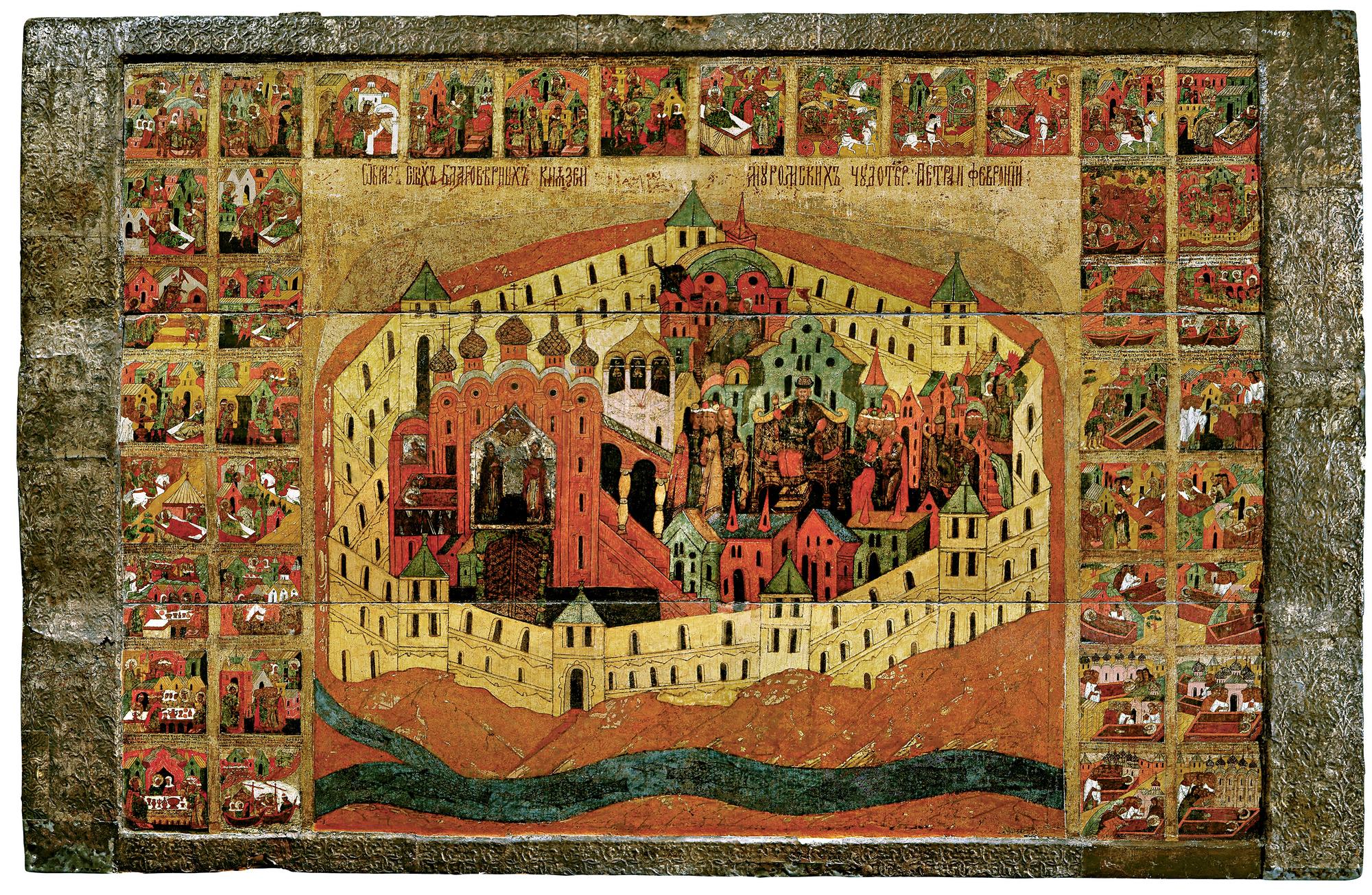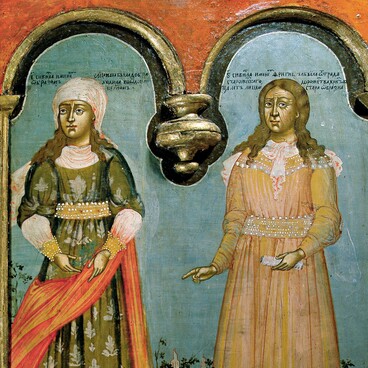The icon of Faithful Saints Prince Peter and Princess Fevronia of Murom was painted by an unknown artist in late 16th – first third of 17th century. Initially the icon was in the Church of Nativity of the Holy Virgin in Murom that held the relics of Saints Peter and Fevronia.
The icon differs from other similar pieces in that its centerpiece does not portray the saints. It shows the city of Murom instead. Three icons of this type survived. This image was created during the formation period of Peter and Fevronia’s cult following their glorification at the church council of 1547. At that time they were viewed as new wonder workers.
The literary source for the image was the Tale of Peter and Fevronia of Murom written by Ermolay-Erazm during the reign of tsar Ivan the Terrible. Ermolay-Erazm was a famous ecclesiastical writer and publicist. Metropolitan Macarius instructed him to write a novel about the Murom saints, as the church council of 1547 started the preparation for their canonization. Initially the novel was intended as prescribed reading for the festive vigil on the commemoration day of the Murom wonder workers.
According to the tale, Peter was the younger brother of the Murom Prince Pavel. A “fornicary serpent” – turn skin came to his wife disguised as Pavel. Peter defeated him with the miraculous Agric sword and got ill from poisonous drops of the serpent’s blood that fell on his body. Peter was cured by wise virgin Fevronia from the village of Laskovo near Ryazan which he married.
After the death of his older brother Peter inherited the principality. Proud Murom boyar and their envious wives did not want to obey the commoner Princess and asked Peter to marry another woman. But he followed exiled Fevronia telling them: ‘If anyone leaves his wife because of formicary speeches and marries another, he engages in adultery’. Soon God’s wrath fell on the city of Murom: a bloody boyar feud. The people of Murom demanded the return of their lawful rulers. In the end of their earthly life the faithful spouses took monastic vows with the names of David and Euphrosyne.
The icon differs from other similar pieces in that its centerpiece does not portray the saints. It shows the city of Murom instead. Three icons of this type survived. This image was created during the formation period of Peter and Fevronia’s cult following their glorification at the church council of 1547. At that time they were viewed as new wonder workers.
The literary source for the image was the Tale of Peter and Fevronia of Murom written by Ermolay-Erazm during the reign of tsar Ivan the Terrible. Ermolay-Erazm was a famous ecclesiastical writer and publicist. Metropolitan Macarius instructed him to write a novel about the Murom saints, as the church council of 1547 started the preparation for their canonization. Initially the novel was intended as prescribed reading for the festive vigil on the commemoration day of the Murom wonder workers.
According to the tale, Peter was the younger brother of the Murom Prince Pavel. A “fornicary serpent” – turn skin came to his wife disguised as Pavel. Peter defeated him with the miraculous Agric sword and got ill from poisonous drops of the serpent’s blood that fell on his body. Peter was cured by wise virgin Fevronia from the village of Laskovo near Ryazan which he married.
After the death of his older brother Peter inherited the principality. Proud Murom boyar and their envious wives did not want to obey the commoner Princess and asked Peter to marry another woman. But he followed exiled Fevronia telling them: ‘If anyone leaves his wife because of formicary speeches and marries another, he engages in adultery’. Soon God’s wrath fell on the city of Murom: a bloody boyar feud. The people of Murom demanded the return of their lawful rulers. In the end of their earthly life the faithful spouses took monastic vows with the names of David and Euphrosyne.



